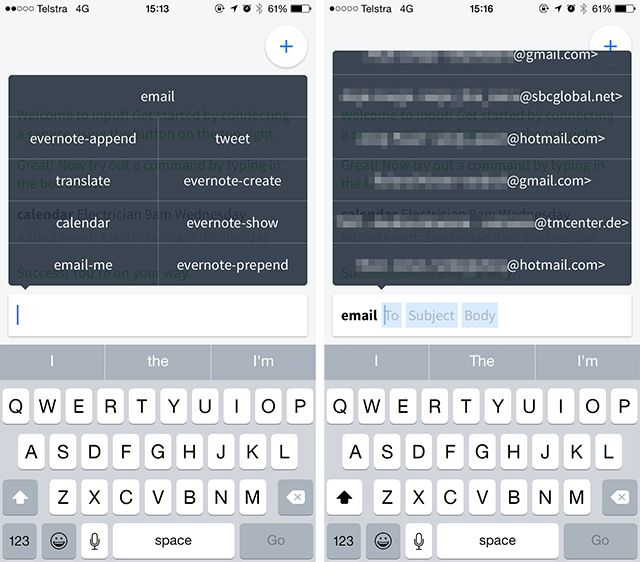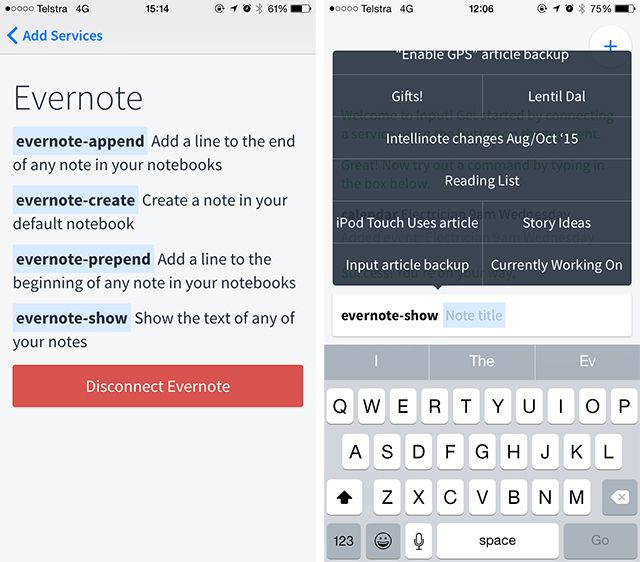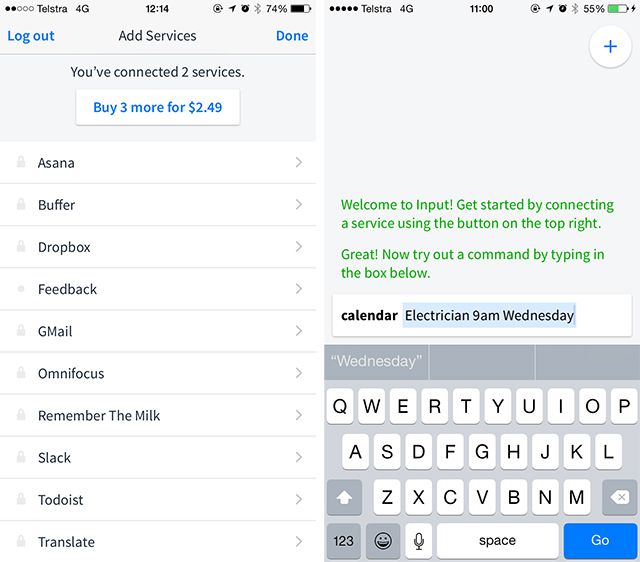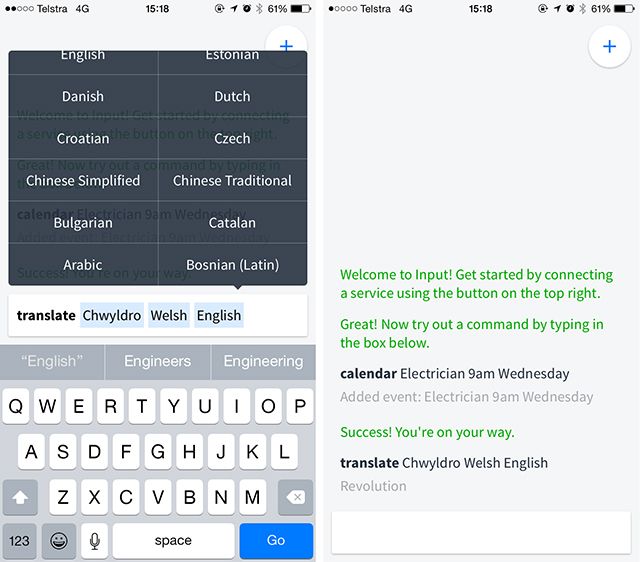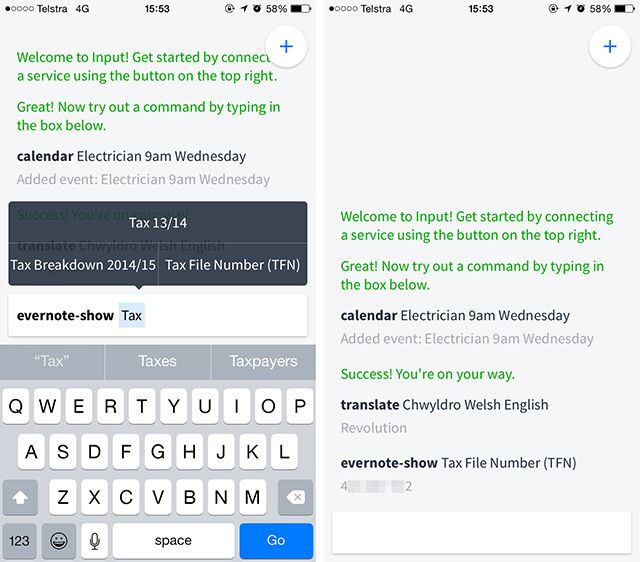Imagine if you could create notes, add calendar appointments and keep your to-do list up to date using a single intuitive command line. That's the idea behind new iPhone app, Input [No Longer Available].
Rather than accessing each service you want to use on an individual app basis, Input offers an opportunity to perform common tasks for services like Evernote, Google Calendar and Wunderlist all from the same interface.
Here's how a rather excellent concept translates into a functional app.
A Command Line for Everything
What do you do when you want to, say for example, create a new calendar appointment? You probably look for your Calendar app (which may or may not involve browsing folders or searching Spotlight), launch it, hit new appointment, and enter a title before adding relevant time and date information.
To do the same with Input, you launch the app and type:
calendar Electrician 9am Wednesday
This creates an hour-long appointment simply titled "Electrician" at 9am local time on the next occurring Wednesday. Adding calendar appointments using natural language isn't anything new — Fantastical has had the feature for a while, and there are plenty of other solutions that use a similar technique.
Input takes the concept a step further by applying it to a wide range of services, establishing itself as a command line for just about everything — though the list of connected services isn't quite as exhaustive as many of us would like. At launch, the following services are compatible with Input:
- Tasks/Organisation: Asana, Omnifocus, Remember the Milk, Todoist, Wunderlist, Evernote and Google Calendar.
- Communication/Social: Gmail, Slack, Buffer and Twitter.
- Others: Dropbox, Venmo, Translate and Feedback (for providing feedback to developers).
Command line interfaces always provide faster results than equivalent graphical interfaces, but having to remember exact syntax and complex commands isn't a very user-friendly approach. Input simplifies this by automatically suggesting relevant commands, so it's essentially impossible to "forget" how to use a service.
Some useful commands include sending email via your Gmail account, paying a friend some money with Venmo, appending a text document in Dropbox and translating text on the fly.
Integrations & In-App Purchases
Input's free version is limited to a maximum of two simultaneous integrations, though you can expand the app's possibilities and add another three services for $1.99. This is where Input can get very expensive, very quickly — though at this early stage in the game there probably aren't enough services at present to justify more than a $4 investment.
Input's usefulness is essentially limited by each relevant service's API, and how developers allow third parties to interact with their services. As an example, Evernote includes four commands:
evernote-append
,
evernote-create
,
evernote-prepend
and
evernote-show
. These do exactly what you'd expect them to: they allow you to append, create, prepend and display notes.
Auto-suggestions aren't only limited to commands, and content relevant to the service you are using will pop up as you type commands. In the example of Evernote, typing evernote-show provides a list of recent notes you can tap, or you can start typing the name of a note to see more specific suggestions.
Not all integrations are equal, and some services support very few commands. Slack only allows you to send a message to a single channel while it should come as little surprise that Wunderlist, Todoist, Asana and Omnifocus only allow you to create new tasks. What's more, services provided by your employer (like Slack and Google Apps accounts) may limit third-party app access.
Input doesn't need an Internet connection to work, and stores any requests you enter until you're back online. If you keep Input pinned to your dock and you're mindful enough to use it properly, it's a wonderfully minimalist way of achieving common tasks — and it'll save you time too.
What Next for Input?
We spoke to Input developer Matthew Healy, who initially created Input as a personal project: "Ultimately, I built Input so I could spend less time looking at my phone when it counts," he said.
"I started working on it about a year ago, and at that point it was a server-only app that I interacted with via SMS. As I continued to hook it up to more of the apps and services I used, I found myself wanting a few features that didn’t work within the confines of text messaging."
It was at this stage Matthew refined Input's user-friendliness, adding quick shortcuts for various service functions (like "evernote-append") and adding auto-complete "to cut down on the amount of typing necessary."
At some point in his quest Matthew decided that what he was building had value to other people: "I scrapped all of my sloppy code from the first two iterations and rebuilt it from the ground-up as a native iOS app. The third time around I was able to work very quickly and write much cleaner code, having made a lot of the decisions about features and data models in the first two prototypes."
Input's current list of services was built up over time based on requests from around 100 of Matthew's beta testers, but more are on the way: "There’s room for many more. I’m hoping that having Input in the hands of a lot more people will mean a lot more requests, so I can quickly expand the list of available services."
I hinted that personally, I'd prefer to spend more money on a "pro" version of the app that doesn't limit the number of services you can connect: "This model gives people a chance to try it out and see if it works for them before spending money, which I think is essential for this kind of app," Matthew said.
"I might consider other pricing models in the future, especially if there are specific features that might make sense for a "pro" version."
Smarter Smartphone Interactions
Input is an app that offers shortcuts to commonly-used functions by eliminating certain steps in your workflow. This approach is most comparable to an app like Alfred for OS X, but nothing quite like Input exists on iOS at present. Truly, this is an innovative app.
Input probably has most in common with personal assistant apps like EasilyDo, without the emphasis on fetching information or automation. There are elements of IFTTT, time-saving app Workflow and Fantastical in there — but nothing feels directly comparable.
As for an Android version, Matt told us: "I'd love to do one soon, if Input proves successful on iOS."
Have you tried Input yet? What do you think?


